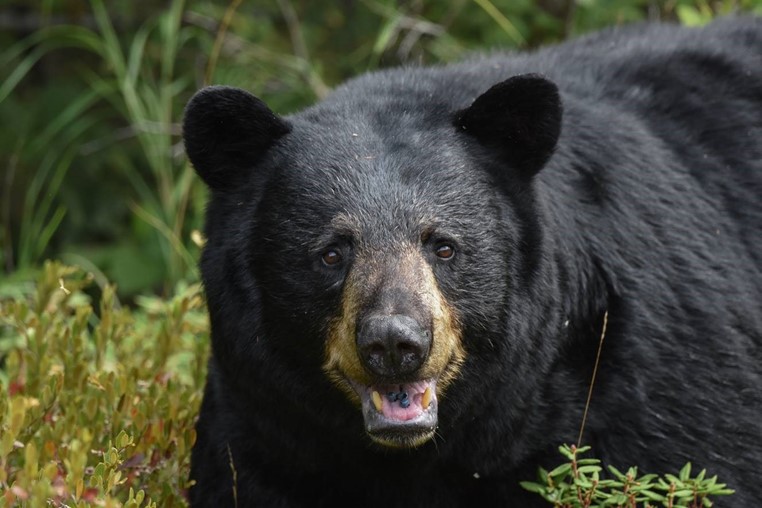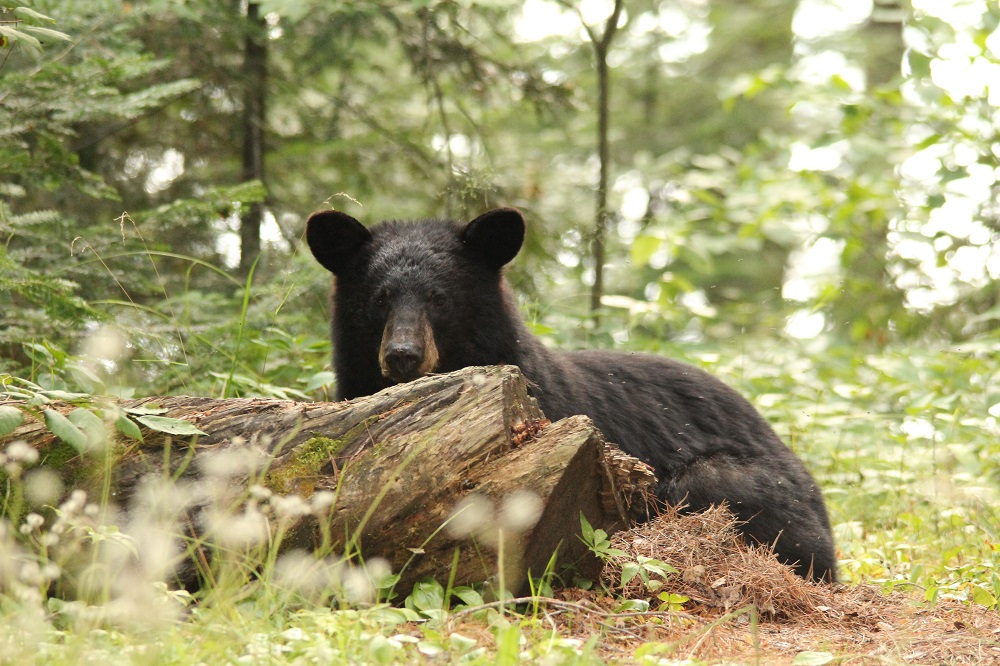Berries are finally ripening, and it is time for Black Bears in Ontario to start packing on the pounds.
In July, breeding season ends and Black Bears get down to the serious business of consuming as much food as they can.
Bears will forage on blueberries, raspberries, cherries, and blackberries.
In fact, 90% of their diet is plant matter like berries and nuts, as well as insects.
While bears are considered carnivores, their diet is omnivorous, and mostly plant based.
What time of day are bears active?
Black Bears are most active during crepuscular hours — dawn and dusk.
This time of day is generally cooler, and in areas where bears share the landscape with people, there is less human activity.
That’s not to say that you’ll never see a bear in the daytime!
When natural foods are ripe, bears are actively feeding many hours of the day.
If you’re hiking in an area of excellent blueberry production in bear habitat, there are likely bears around.
Learn more about taking simple steps to avoid bear encounters.
How do bears deal with heat while sporting a thick fur coat?
Bears deal with heat various ways.
It tends to be cooler at dawn and dusk when bears are most active.
Just like us, bears are no stranger to swimming in lakes, ponds, and other bodies of water to cool off.

In the heat of the day, bears will also bed down in a shady area.
To prepare for the summer, bears lose their underfur to dissipate heat better and will lay their sparsely-furred bellies on the ground to cool off.
Is that a cub or a yearling?
Females with cubs are actively moving around in search of food, and mom is teaching her babies how to act like a bear.
Cubs are quite active now and are able to follow mom around. They’re eating natural foods, but still nursing.
When people see smaller bears, it can be difficult to tell whether it is a cub, who would have a mom around close by, or a yearling, who is not accompanied by an adult.
Bear cubs born this year are about the size of a raccoon or small dog in July.
Yearling bears are the size of a medium to large dog in July, but this can vary widely based on sex and food abundance.
Yearling bears have ears that appear very large for their head, and their limbs can also appear long in relation to their body size. These bears appear lanky and clearly not full grown.
A built-in navigation system
Black Bears are renowned for their ability to navigate the landscape.
When they find food, they log it into long term memory. Using their excellent memory, bears can travel over 150 kilometres outside of their normal home range to locations of abundant food.

Data from bears fitted with GPS collars suggests these bears knew exactly where they were going and how to get back, due to the almost direct path of travel.
Year after year, bears will travel to known areas in search of reliable food sources, like a blueberry field, a stand of oak or beech trees with acorns and beech nuts, or a creek where they can capture fish in the spring.
How much can a bear eat?
When preparing for hibernation, Black Bears can consume up to 20,000 calories per day.
That is about ten times the amount of food for an average human!
However, they’re not always eating this much. In the spring, natural foods are not abundant. But come summer, bears ramp up their appetite.
When foods are available, bears are busy eating as much as they can.
What is 20,000 calories in bear terms?
It’s about 78 pounds of blueberries or 9 pounds of acorns.
When natural foods are ripe, bears need to eat, and they will spend hours every day to get the calories they need. You can imagine how hard it would be to forage that amount of food every day unless foods are abundant.

You can also see why a cooler packed with a weekends supply of food for four people would be a very enticing prospect for a hungry bear!
This is why it is so important to manage your food and other wildlife attractants properly when visiting Ontario Parks.
What do you mean by “storing your wildlife attractants properly”?
Storing wildlife attractants properly means making sure wildlife is not able to access the items.
Wildlife needs to stay wild, for their safety and ours.
Do not intentionally feed wildlife, and make sure that any items you have are inaccessible to wildlife like chipmunks, squirrels, and bears.
Keeping items in anything that can be easily broken into (like a tent) is not proper storage.
Wildlife attractants are anything that would attract wildlife, like human or pet food, birdseed, toiletries, and really anything smelly that they may want to investigate.
Garbage is also a wildlife attractant because of the leftover food it contains, and the strong odour.

Many campgrounds have installed bear-proof food storage for those without vehicles on site.
If these are available at your campsite, use a lock and stash your cooler and other wildlife attractants when not in use.
If you are camping with your vehicle, store all food and other wildlife attractants in your trunk.
Lock the vehicle doors and shut all windows.
Bears can break open a window left open and can easily get into all types of covers for truck boxes.
If you drive a vehicle without a trunk, lock the food and other items in the passenger compartment, ensure the windows are shut, and lock the doors.
It’s a good idea to cover your cooler with a blanket, too.
Any garbage you have should be frequently taken to disposal sites, and not left unattended on your campsite.
Be Bear Wise
Black Bears are amazing animals.
Let’s all do our best to respect and coexist with the Black Bears who call our protected areas home!








